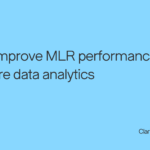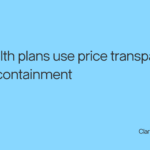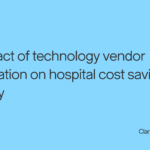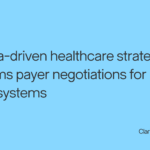Approximately 4.3 trillion dollars are spent annually on US healthcare costs and, of this amount, 31% is provided for hospital services. One driver of rising healthcare costs is pricing, particularly the pricing of hospital services, which have been notoriously difficult to see in advance of treatment, and even more difficult to compare across providers and networks. This black box prevents commercial payers, employers, and patients from selecting more affordable healthcare providers and allows some hospitals to charge commercial payers service rates far above those set by public payers such as Medicare. While there has been substantial progress since CMS first released hospital charges for inpatient services in 2013, there is still much we do not know. To address concerns around high and rising commercial price levels for hospital admissions and other healthcare services, the Centers for Medicaid and Medicare Services (CMS) implemented two new regulations to promote commercial price transparency. As of January 2021, hospitals are required to publish their charge prices, contract rates for each contracted payer network, cash discount rates, and the minimum and maximum payments for all services. Current estimates of hospital compliance range from 23 to 70 percent, leading to calls by Congress for more federal oversight and enforcement to increase hospital compliance. There is also wide variation in how hospitals are complying, with some providing incomplete data, some posting data but not a patient dashboard, some using non-standard descriptions of services, and others doing some combination of the above. Effective July 1, 2022, payers are also now required to disclose in-network rates negotiated for all healthcare services, not only with hospitals but also organizations such as physician groups and ambulatory surgical centers. This is allowing greater insights into costs of care, providing access to allowed amounts irrespective of cost sharing. Whether patients, many of whom are protected from cost differences, are willing or able to shop around for lower-cost medical services remains to be seen, but they will now for the first time be given the chance. Moreover, the release and analysis of price transparency data will have a transformative impact on payer-provider negotiations. To further assess public reporting of healthcare services pricing data under these new regulations, Clarify Health Solutions and the Clarify Health Institute have compiled and reviewed an aggregate collection of national commercially negotiated rates data posted by hospitals and payers. Our research documents the high levels of and variation in commercially-negotiated rates. On an ongoing basis we are estimating the impact of new price transparency regulations on rates for hospital and other healthcare services and highlighting how providers and payers are leveraging publicly available rates data in their commercial rate negotiations. Over the past year and half, Clarify has worked to compile and aggregate publicly posted payer and provider rates. This is a resource-intensive process consisting of scraping individual payer and hospital websites for machine-readable files (MRFs) posted due to the price transparency regulations. Following aggregation of the raw rates data, several data cleaning and enrichment steps are taken to facilitate review. This includes combining rates with claims data and trusted clinical informatics to map standard codes and service lines, estimating Medicare payments for those services, and calculating rates as a percentage of Medicare payments to reflect a common standard of value. We also assess claims volume to determine utilization and remove ‘zombie rates’ reported for providers who have never, and would never, provide certain services (e.g., spinal surgery procedures posted for a clinical laboratory). Ongoing analyses of this enriched data empirically assess: In completing these analyses, we leverage price transparency data from thousands of US hospitals and payer-reported data from over 65 national and regional payers. Clarify will present additional analyses at HIMSS that will illustrate how negotiated rates for healthcare services may be compiled and analyzed. As publicly reported rates data are updated over time, our analyses will also document how levels of negotiated rates are changing in response to price transparency regulations. Clarify has processed, analyzed, and compared data sourced from approximately 5,600 hospitals and over 65 large national and regional payers since their inception to assess quality differences between the data sources. We have observed: An independent review of hospital reporting compliance completed by Patient Rights Advocate estimates that as of February 2023, only one in four hospitals is currently compliant with the regulations. Several major health systems, including Avera Health, Christus Health, Mercy Health, Tenet Healthcare, as well as hundreds of independent hospitals in many states are completely non-compliant. To demonstrate the superior coverage of payer-reported rates, consider the below coverage maps generated by Clarify. Separately for hospital-sourced rates and rates reported by five payers (Aetna/CVS, BCBS, Centene, Cigna, and UnitedHealthcare), we estimate coverage of hospitals (identified by CMS CCN IDs) with at least one MS-DRG rate by ZIP-3 codes in each data source. While in some markets coverage of hospital-reported negotiated rates is reasonable, notable gaps in rates reported for inpatient MS-DRGs exist relative to payer-reported rates. Combined with a complete absence of professional services codes (which are also billed in inpatient settings) and greater incentives for payers to comply with reporting requirements, Clarify and the industry are placing increased trust in payer rates-based analyses. On average, we estimate commercially negotiated rates for MS-DRGs are reimbursed at 237% of the Medicare payment amount. This percentage can range substantially, with the bottom ten percent of inpatient rates falling below 120% of Medicare and the top ten percent above 365%. In exploring the payer-sourced negotiated rates further, we document substantial price variation both across markets and within markets throughout the US for specific services. For example, clear variation is evident across inpatient rates paid by commercial plans to hospitals as part of a C-section admission. Similar to the coverage maps, this figure presents the median negotiated inpatient rate for a C-section admission (MS-DRG 788, ‘Cesarean Section Without Sterilization Without CC/MCC’) estimated from payer rates reported by five national payers. Nationally, estimated payment rates vary by over $32k! We are similarly able to document substantial differences in payment within ZIP-3 codes, as shown in the above map presenting interquartile differences in the negotiated rate for MS-DRG 788. Local payments are sometimes uniform ($0) but can also vary dramatically; up to a maximum interquartile difference of over $46k in the Miami area. Our findings are consistent with prior research, but leverage national data for assessment at a scale not previously available prior to the release of price transparency data. For example, we also estimate a substantial markup for commercial payers relative to the payments set by Medicare Part A for the same services. While such findings are consistent with prior research by RAND, the Urban Institute, and others, price transparency data and Clarify’s enrichment methods allows new opportunities for insights. Results to be revealed at HIMSS will highlight the substantial current markups vs. Medicare across most inpatient services. Our analyses of newly available negotiated rates data highlight widespread variation in prices and high levels relative to Medicare benchmarks across a breadth of healthcare services provided by US hospitals. These findings reinforce the lack of consistent pricing for healthcare services provided to commercial payers and their insured patients as well as the high cost of hospital utilization in the US. Persistent healthcare cost inflation over time and increasing concentration across the healthcare industry are important topics to further consider using these newly available data sources. Increased transparency around negotiated commercial rates, when combined with other sources of information, also has potential to spur additional innovation throughout the healthcare system in multiple ways. New entrants may better target local healthcare markets or service categories where rates are particularly non-competitive. Payers may assess newly developed strategies for shifting procedure volume away from high-cost inpatient settings to lower-cost, comparable quality outpatient settings. Finally, state and other local governments may reassess anticompetitive regulatory policies, such as certificate-of-need (CON) regulations, if these continue to be found to be associated with higher markup in commercially negotiated rates. Newly available price transparency data will likely impact US healthcare delivery and financing in other unexpected ways and ongoing evaluation of these changes will be critical to assess this impact in the years ahead. Niall Brennan, chief privacy and analytics officer at Clarify Health and head of The Clarify Health Institute, will be leading a session at HIMSS on how hospitals and payers are leveraging publicly available rate data in their commercial rate negotiations through Clarify’s ongoing review of updates to publicly reported data on negotiated prices. Don’t miss this session to learn more about which types of service lines experience greater variation in pricing and how market competitiveness plays a role in negotiations. You can learn more about Clarify’s presence at HIMSS23 here: https://clarifyhealth.com/himss2023/. Clarify Health offers on-demand software for rich intelligence on healthcare rates negotiated between health insurance companies and providers. With 500+ terabytes of price transparency data that has been enriched with Clarify’s claims data, consisting of 300M+ annual lives, users can download hundreds of prices that have actually been billed (instead of viewing millions of meaningless prices). The software has a no-code query engine that delivers insights in seconds instead of hours. It can instantly run queries on our massive data set, dynamically filter prices by over 15 categories, benchmark rates to Medicare and regional averages, and even create executive-level dashboards.Aggregating, cleaning, and enriching price transparency data
The simple truth about hospital-reported price transparency data
Inpatient prices vary dramatically
C-section prices vary by over $32,000 across the US
C-sections prices also can vary by thousands of dollars within the same market
Where to next? Understanding drivers of variation
Learn more at HIMSS23
Price Transparency Solutions
- Author Details





